I am trying to draw a ring/partial ring using arc's.
But I need the middle of the partial ring/ring to be transparent and show whats behind it. Since I am using an arc and spinning it, is there a way to subtract away the inner portion of each arc and leave only the end at the desired thickness which will be spun to create the ring?
This is my code so far: I have the arcs working, but I am only simulating the ring by layering over each one with a couple circles, I need to actually subtract out the area of each circle from each arc.
Not sure how to do that to achieve transparency in the center. If there is a better way to do this please let me know, this is going to be a custom progress bar.
public class JCustomProgressBar extends JComponent{
private final Dimension SIZE = new Dimension( 50, 50 );
public JCustomProgressBar() {
super();
this.setVisible(true);
System.out.println("CAlled");
}
int progress = 1;
public void updateProgress (int progress){
this.progress = progress;
}
@Override
public void paintComponent (Graphics g){
super.paintComponent(g);
System.out.println("called");
Graphics2D g2D = (Graphics2D) g.create();
g2D.setRenderingHint(RenderingHints.KEY_ANTIALIASING, RenderingHints.VALUE_ANTIALIAS_ON);
g2D.translate(this.getWidth()/2, this.getHeight()/2);
g2D.rotate(Math.toRadians(270));
Arc2D.Float arc = new Arc2D.Float (Arc2D.PIE);
Ellipse2D circle = new Ellipse2D.Float(0, 0, 80, 80);
arc.setFrameFromCenter (new Point(0,0), new Point (90, 90));
circle.setFrameFromCenter(new Point(0,0), new Point (80, 80));
arc.setAngleExtent(-progress*360/100);
g2D.setColor(new Color(120,192,0));
g2D.draw(arc);
g2D.fill(arc);
g2D.setColor(this.getParent().getBackground());
g2D.draw(circle);
g2D.fill(circle);
arc.setFrameFromCenter (new Point(0,0), new Point (75, 75));
arc.setAngleExtent(-90*360/100);
g2D.setColor(new Color(197,228,146));
g2D.draw(arc);
g2D.fill(arc);
circle.setFrameFromCenter(new Point(0,0), new Point (70, 70));
g2D.setColor(this.getParent().getBackground());
g2D.draw(circle);
g2D.fill(circle);
circle.setFrameFromCenter(new Point(0,0), new Point (60, 60));
g2D.setColor(new Color(245, 245, 245));
g2D.draw(circle);
g2D.fill(circle);
g2D.setColor(Color.black);
g2D.rotate(Math.toRadians(90));
g2D.setFont(new Font("Verdana", Font.PLAIN, 30));
FontMetrics fm = g2D.getFontMetrics();
Rectangle2D r2D = fm.getStringBounds(progress + "%", g);
int x = (0 - (int) r2D.getWidth())/2;
int y = (0 - (int) r2D.getHeight())/2 +fm.getAscent();
g2D.drawString(progress + "%", x, y-10);
//Rectangle2D r2d = fm.getStringBounds(progress + "", g);
// g2D.setFont(new Font("Verdana", Font.PLAIN, 22));
// g2D.drawString("%", x + 40, y-10);
g2D.setFont(new Font("Verdana", Font.PLAIN, 15));
g2D.drawString("Progress", -35, y+5);
g2D.dispose();
}
}
